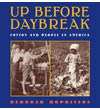 |
|||||
|
|
Book Focus - April 2006Up Before Daybreak: Cotton and People in America When Deborah Hopkinson first pitched the idea for Up Before Daybreak: Cotton and People in America, I could not help but think, cotton? How, I thought to myself, could a book about a fabric compete with dragons and wizards for the attention and imagination of young readers? Still, after having worked with Deborah on Shutting Out the Sky, a wonderful book about the tenements and immigrant culture of New York’s Lower East Side, I had endless faith in her writing, and admired her ability to bring history to life. I trusted Deborah wholeheartedly, and waited impatiently for her manuscript. Needless to say, when it finally arrived, I was awed. I was struck by her ability to make what could have been dry history in other hands, vibrant and compelling, and to bring to life the people of the past, with their speech and song, their joy and sadness. This, I realized, was Deborah’s great gift. Where others saw dreary and dusty archives, she lent her ear to the whispers of the past and never stopped listening until the whispers grew into a coherent voice, loud and clear. From Sarah Gudger, a former slave who was interviewed by the Federal Writers project, to Lucy Larcom, a mill worker who dreamed of leaving the cotton mills to go to school, the people in Deborah’s book would have been lost, condemned to oblivion but for her discerning eye and sharp pen. In Up Before Daybreak, these unfortunate young Americans are paid the highest tribute of all: Their life stories are lifted from the musty records where Deborah undoubtedly found them, and retold in a manner so fluent and compelling that readers young and old will find themselves mesmerized. As Deborah pulled together the strands of the story, a larger thread began to come into focus: The story of our nation. Cotton played such an important role in American history and in the lives of millions of Americans; when woven together, the biographies of slaves and landlords, of sharecroppers and mill workers, a historical mosaic emerges, telling the story of a nation rapidly growing and bitterly struggling to define itself. This, perhaps, was what amazed me most about the book; so personal and intimate in its portrayals of its characters, it nonetheless succeeds in being a bold, sweeping history of the nation viewed through the perspective of cotton farming and production, covering anything from America’s birth pangs and the invention of the cotton gin to the Great Depression a century and a half later. Deborah’s lucid prose, however, makes up only part of this wonderful book. Having scanned the nation’s photo archives, from the Library of Congress to the American Textile History Museum in Lowell, Massachusetts, Deborah found the perfect photographs to illustrate her story. These portraits of Americans, black and white, battling the unremitting earth to eke out a living are haunting; each, in a quiet but powerful way, bids the reader a compelling command: Care. And young readers, I believe, will. I remember being a girl myself, imagining what daily life was like in different eras, different places, but finding it hard to make sense of the lists of dates and events and names that I often encountered in text books. My sense of curiosity, my innate desire to hear a good story, however, never flagged, and I have a feeling that a lot of kids just might feel the same way. In Up Before Daybreak, young readers will find all the staples of great storytelling, such as memorable characters and dramatic plotlines, but will also feel, I hope, a particular sense of enjoyment knowing that everything they’re reading is true. The book, then, is not only a great way to teach kids about American history, but also to bring to their attention, in a sensitive and intriguing way, such important issues as child labor, poverty, and racism. Herein, lies the real magnitude of Deborah’s achievement,
of which I am so proud to be a part. She has given us a sterling
example of how to write nonfiction for children, nonfiction that
will read like a page-turner without compromising or watering down
the subject matter, that is educational without being preachy, that
will grab anyone who thumbs through the pages and make them understand
that in reading about cotton, quite literally the fabric of our
society and history, one can gain all the insight and satisfaction
usually reserved for the truly great novels. |
||||
